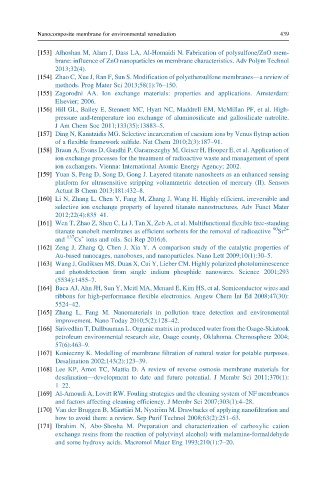Page 486 - Polymer-based Nanocomposites for Energy and Environmental Applications
P. 486
Nanocomposite membrane for environmental remediation 439
[153] Alhoshan M, Alam J, Dass LA, Al-Homaidi N. Fabrication of polysulfone/ZnO mem-
brane: influence of ZnO nanoparticles on membrane characteristics. Adv Polym Technol
2013;32(4).
[154] Zhao C, Xue J, Ran F, Sun S. Modification of polyethersulfone membranes—a review of
methods. Prog Mater Sci 2013;58(1):76–150.
[155] Zagorodni AA. Ion exchange materials: properties and applications. Amsterdam:
Elsevier; 2006.
[156] Hill GL, Bailey E, Stennett MC, Hyatt NC, Maddrell EM, McMillan PF, et al. High-
pressure and-temperature ion exchange of aluminosilicate and gallosilicate natrolite.
J Am Chem Soc 2011;133(35):13883–5.
[157] Ding N, Kanatzidis MG. Selective incarceration of caesium ions by Venus flytrap action
of a flexible framework sulfide. Nat Chem 2010;2(3):187–91.
[158] Braun A, Evans D, Gandhi P, Garamszeghy M, Geiser H, Hooper E, et al. Application of
ion exchange processes for the treatment of radioactive waste and management of spent
ion exchangers. Vienna: International Atomic Energy Agency; 2002.
[159] Yuan S, Peng D, Song D, Gong J. Layered titanate nanosheets as an enhanced sensing
platform for ultrasensitive stripping voltammetric detection of mercury (II). Sensors
Actuat B Chem 2013;181:432–8.
[160] Li N, Zhang L, Chen Y, Fang M, Zhang J, Wang H. Highly efficient, irreversible and
selective ion exchange property of layered titanate nanostructures. Adv Funct Mater
2012;22(4):835–41.
[161] Wen T, Zhao Z, Shen C, Li J, Tan X, Zeb A, et al. Multifunctional flexible free-standing
titanate nanobelt membranes as efficient sorbents for the removal of radioactive 90 Sr 2+
+
and 137 Cs ions and oils. Sci Rep 2016;6.
[162] Zeng J, Zhang Q, Chen J, Xia Y. A comparison study of the catalytic properties of
Au-based nanocages, nanoboxes, and nanoparticles. Nano Lett 2009;10(1):30–5.
[163] Wang J, Gudiksen MS, Duan X, Cui Y, Lieber CM. Highly polarized photoluminescence
and photodetection from single indium phosphide nanowires. Science 2001;293
(5534):1455–7.
[164] Baca AJ, Ahn JH, Sun Y, Meitl MA, Menard E, Kim HS, et al. Semiconductor wires and
ribbons for high-performance flexible electronics. Angew Chem Int Ed 2008;47(30):
5524–42.
[165] Zhang L, Fang M. Nanomaterials in pollution trace detection and environmental
improvement. Nano Today 2010;5(2):128–42.
[166] Sirivedhin T, Dallbauman L. Organic matrix in produced water from the Osage-Skiatook
petroleum environmental research site, Osage county, Oklahoma. Chemosphere 2004;
57(6):463–9.
[167] Konieczny K. Modelling of membrane filtration of natural water for potable purposes.
Desalination 2002;143(2):123–39.
[168] Lee KP, Arnot TC, Mattia D. A review of reverse osmosis membrane materials for
desalination—development to date and future potential. J Membr Sci 2011;370(1):
1–22.
[169] Al-Amoudi A, Lovitt RW. Fouling strategies and the cleaning system of NF membranes
and factors affecting cleaning efficiency. J Membr Sci 2007;303(1):4–28.
[170] Van der Bruggen B, M€ antt€ ari M, Nystr€ om M. Drawbacks of applying nanofiltration and
how to avoid them: a review. Sep Purif Technol 2008;63(2):251–63.
[171] Ibrahim N, Abo-Shosha M. Preparation and characterization of carboxylic cation
exchange resins from the reaction of poly(vinyl alcohol) with melamine-formaldehyde
and some hydroxy acids. Macromol Mater Eng 1993;210(1):7–20.

